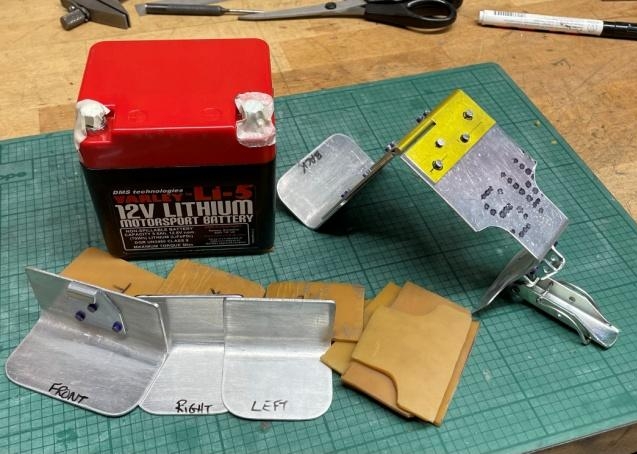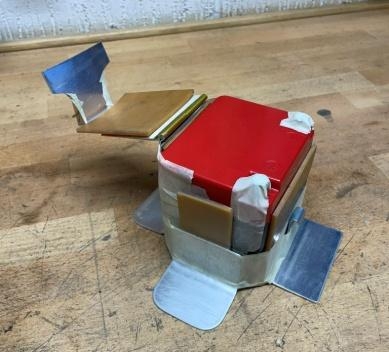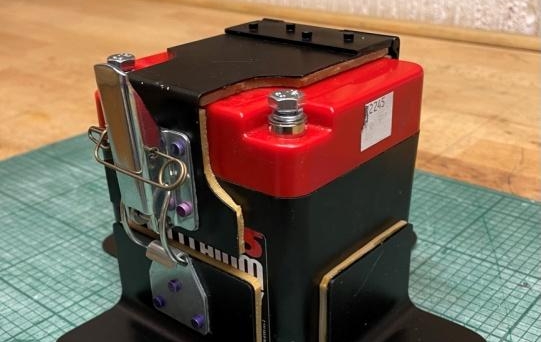Let’s be absolutely clear. When the manufacturer designed and produced the Auster Mk1, there was never any inkling that electrical power to the cockpit would be a requirement. So no battery needed for this old lady. The propeller is swung by hand, the engine-driven magnetos provide power to the spark plugs, all the instrumentation is mechanical and back then, hand signals and perhaps an Aldis signal lamp were the likely forms of communication to those outside the aircraft. Who needs a battery?
Well we do. Operating a 1942 era aircraft in 2023 airspace brings a few safety requirements and the convenience of being able to communicate with other operators by radio is argued by some of our more demanding pilots as a necessity! So we need to fit a battery to power our Mode S Transponder and the VHF radio.

Original wooden tray and cloth shroud behind pilot and co-pilot

New wooden tray to be mounted behind the pilots – for the VHF, Mode S and batteries
The original fit inside the cockpit and (micro) cabin included a utilities wooden tray just behind the pilot and co-pilot/observer seats. In 1942, I suspect this will have been used to hold maps and some “pilot essentials” (butties, sweetie bars, thermos flask; and a dashing hat and scarf for wearing during ground operations). Our tray was very tired and ready for replacement. And the “shroud”, a piece of material nailed to the tray and the surrounding framework, closing off the view down the inside of the fuselage, was rotten.
The plan, (beautifully designed and drawn by our very own Phil Russell), is to re-purpose the utilities tray for all the avionic gubbins needed to connect our pilots to other operators with a nice new VHF radio setup while letting all and sundry know where we are via a Mode S Transponder. Oh, and we would fit the battery onto the tray as well.
Following much counting work with fingers and toes, some back-to-basics maths and resurrection of long-unused formulae, we calculated just how many wiggly-amps the system would draw at full power for at least a full tank of petrol. So with a healthy margin for safety, that’s two batteries required! Fortunately there is room for two so with a bit of drawing re-work; we carried on with the plan.
Having purchased the LAA-approved batteries and suitable chargers, we needed to make two quick-release battery mounts to go onto the tray. Why quick-release I hear you say? Well the engine has no way of providing charging power so the system has to be total-loss. The operating ethos is that there will be more than enough power in the batteries to support even an extended flight/transit. At destination, the pilot will be able to simply remove the batteries and take them in a bag, with the chargers, to his (or her) 5* aircrew accommodation and charge them overnight.
So loaded with some (hefty) alloy sheet, Dave Currie bent up a handful of 90 degree angled strips and donated them to the pot of materials needed for the battery box construction job. Armed with this and a big sheet of light alloy, construction began in a small secluded workshop, somewhere in deepest darkest Wiltshire.
The plan was to use the 90 degree angle brackets for most of the locating and holding work while making a hinged bracket with an over-centre clasp to lock the battery in place.

Bag of bits used to construct the battery boxes

Angle brackets, hinged clasp assembly, battery and assorted rubber strips ready for mocking up the fit.

First mock-up

Paint and rubber pads applied

Hinged cover attached and the over-centre clasp installed.
Next step, having made two battery mounting kits, was to pass the bits onto our resident Fixed-Wing-Aircraft Avionic-Systems-Installation and Modification Team (FWAASIMT) – Guy Musgrove. Guy is constructing and fitting all the mechanical elements for the avionics tray (a huge task) and will fit the batteries either side of the tray (with the VHF comms and Transponder gear in the centre)

FWAASIMT in action drilling holes in the avionics tray with his Mk1 Hand-Drill! No fancy power tools at the HAAF – everything is age/time authentic – including the trusty volunteer team

Battery installation under way. Pilot holes drilled and sheet-grippers holding it all together before the bolts are fitted.
There is a still lot to do to complete the VHF and Mode S modification……..but for now, this is a great step forward – we have electrical power.

